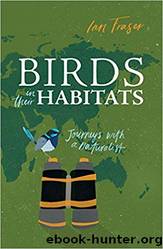Birds in Their Habitats_Journeys With a Naturalist by Ian Fraser

Author:Ian Fraser [Fraser, Ian]
Language: eng
Format: epub
ISBN: 9781486307463
Amazon: B07B2NG5FK
Publisher: CSIRO Publishing
Published: 2018-03-02T00:00:00+00:00
Other memories of mountains
Like fleeting glimpses of snow-slashed black peaks, which loom through gaps in the swirling clouds, then withdraw into the diaphanous curtain, here are some random mountain memories:
⢠High in the Kapteinskloof Mountains north of Cape Town is a private nature reserve called Mountain Mist. I spent a memorable night there some years ago â the views alone are immense, northeast to the rugged Cederberg Mountains and west across the coastal plains 1000 m below to the Atlantic Ocean and Saint Helena Bay (reputedly the largest bay in Africa). As the sun sank over the sea, the distant strip-cultivated plains were charcoal and pale green and the sea was palest misty blue merging into the sky. The foreground tumbled away from my verandah in heath-covered rockiness (âfynbosâ in the local usage). Proteas crowded in, and glowingly glorious Orange-breasted Sunbirds and taxonomically enigmatic Cape Sugarbirds worked the big flowers. The sugarbirds comprise just two species in a Family of utterly uncertain relationships: this one has a curved bill, brown back and white undersides streaked all over, and a hugely long tail. The sun swelled and turned that peculiarly African shade of vermilion just before disappearing. In the dusk, two sugarbirds sat up in silhouette. In the morning, the world on the mountain was in brilliant sunshine but below was a dense white blanket. I inched down the narrow rough road, sometimes through passages cut through the rocks, with mist stifling all views. Sometimes I saw a ghostly sugarbird by the road, once a silhouetted Ground Woodpecker, all in silence.
⢠Another misty day, near the summit of Mount Kosciuszko in Kosciuszko National Park, the highest point of Australia: this is an ancient land that has been eroding away for a very long time and âKosciâ is just 2300 m above sea level. The wind ripped the cloud into shreds but it reformed immediately. It was midsummer, but uncomfortably cold. A small flock of Little Ravens inspected the tumbled granite boulders, intently peering into crevices. They were looking for Bogong Moths: a medium-sized grey moth that emerges in spring on the black soil plains hundreds of kilometres to the north, where the larvae (known as âcut wormsâ) have spent the winter feeding on plant roots. As their âforemothsâ have done for millennia, the adult moths flew south at night, not feeding as they travelled, and spent the days somewhere dark and quiet, be it cave or broom cupboard. They find the same crevices that thousands of previous generations have used and spend summer in partial aestivation in the cool dark crevices. Little Ravens gorge on their fatty bodies, as do antechinuses (small marsupial carnivores). At night, inexplicably, some of the moths fly, though they still donât feed, and bats and Southern Boobook Owls are waiting. In autumn, the survivors fly north again, lay eggs â and die. No moth makes the trip twice: the map is hard-wired into their tiny brains. And each year the Little Ravens will be waiting for them.
Download
This site does not store any files on its server. We only index and link to content provided by other sites. Please contact the content providers to delete copyright contents if any and email us, we'll remove relevant links or contents immediately.
| Amphibians | Animal Behavior & Communication |
| Animal Psychology | Ichthyology |
| Invertebrates | Mammals |
| Ornithology | Primatology |
| Reptiles |
Sapiens: A Brief History of Humankind by Yuval Noah Harari(14252)
The Tidewater Tales by John Barth(12608)
Mastermind: How to Think Like Sherlock Holmes by Maria Konnikova(7227)
Do No Harm Stories of Life, Death and Brain Surgery by Henry Marsh(6891)
The Thirst by Nesbo Jo(6828)
Why We Sleep: Unlocking the Power of Sleep and Dreams by Matthew Walker(6618)
Life 3.0: Being Human in the Age of Artificial Intelligence by Tegmark Max(5474)
Sapiens by Yuval Noah Harari(5294)
The Longevity Diet by Valter Longo(5021)
The Body: A Guide for Occupants by Bill Bryson(4974)
The Rules Do Not Apply by Ariel Levy(4861)
The Immortal Life of Henrietta Lacks by Rebecca Skloot(4525)
Animal Frequency by Melissa Alvarez(4395)
Why We Sleep by Matthew Walker(4360)
The Hacking of the American Mind by Robert H. Lustig(4318)
Yoga Anatomy by Kaminoff Leslie(4306)
All Creatures Great and Small by James Herriot(4233)
Double Down (Diary of a Wimpy Kid Book 11) by Jeff Kinney(4207)
Barron's AP Biology by Goldberg M.S. Deborah T(4099)
